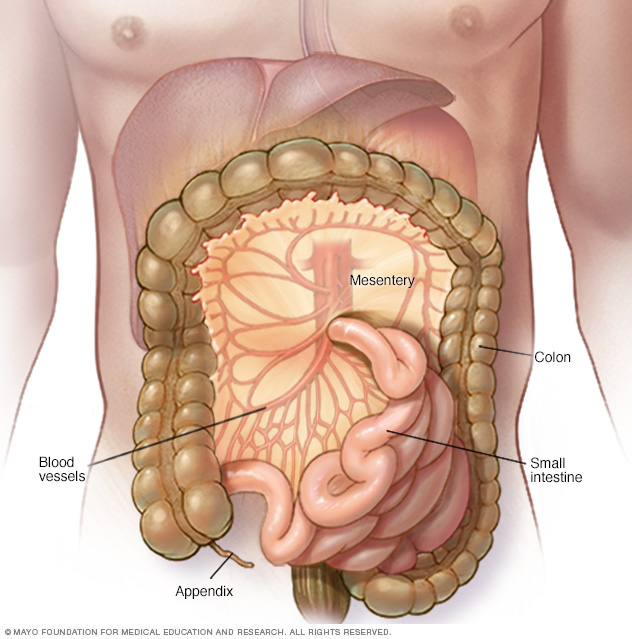Overview
Sclerosing mesenteritis is a condition in which tissue that holds the small intestines in place, called the mesentery, becomes inflamed and forms scar tissue. The condition also is called mesenteric panniculitis. Sclerosing mesenteritis is rare, and it's not clear what causes it.
Sclerosing mesenteritis can cause belly pain, vomiting, bloating, diarrhea and fever. But some people experience no symptoms and may never need treatment.
In rare cases, scar tissue formed by sclerosing mesenteritis can block food from moving through the digestive tract. In this case, you may need surgery.

Symptoms
Symptoms of sclerosing mesenteritis include pain in the belly, vomiting, bloating, diarrhea and fever. Sometimes people don't have any symptoms.
Causes
The cause of sclerosing mesenteritis is not known.
Diagnosis
Tests and procedures used to diagnose sclerosing mesenteritis include:
- Physical exam. During a physical exam, a member of your healthcare team looks for clues that may help find a diagnosis. For instance, sclerosing mesenteritis often forms a mass in the upper abdomen that can be felt during a physical exam.
- Imaging tests. Imaging tests of the abdomen may show sclerosing mesenteritis. Imaging tests may include computerized tomography (CT) or magnetic resonance imaging (MRI).
-
Removing a sample of tissue for testing, called a biopsy. If you're experiencing sclerosing mesenteritis symptoms, a biopsy may be needed to rule out other diseases and to make a definitive diagnosis. A biopsy sample may be collected during surgery or by inserting a long needle through the skin.
Before starting treatment, a biopsy can confirm the diagnosis and rule out other possibilities, including certain cancers such as lymphoma and carcinoid.
Treatment
You may be diagnosed with sclerosing mesenteritis while you are receiving care for another condition. If you are not experiencing discomfort from sclerosing mesenteritis, you may not need treatment. Instead, occasional imaging tests may be recommended to monitor your condition.
If you begin to experience symptoms of sclerosing mesenteritis, you may choose to begin treatment.
Medicines
Medicines for sclerosing mesenteritis are used to control inflammation. Medicines may include:
- Corticosteroids. Corticosteroids such as prednisone control inflammation. Corticosteroids can be used alone but are usually combined with other medicines. They are not generally used for more than 3 to 4 months because of side effects.
- Hormone therapy. Hormone treatments such as tamoxifen (Soltamox)may slow the growth of scar tissue. Tamoxifen is typically combined with corticosteroids or other medicines and may be used long term. Tamoxifen increases the risk of blood clots and is typically combined with a daily aspirin to reduce this risk. Progesterone (Prometrium) may be used as an alternative to tamoxifen, but it also has significant side effects.
- Other medicines. Several other medicines have been used to treat sclerosing mesenteritis, such as azathioprine (Imuran, Azasan), colchicine (Colcrys, Mitigare), cyclophosphamide and thalidomide (Thalomid).
Surgery
You may need surgery if the scar tissue blocks food from moving through your digestive tract.
© 1998-2025 Mayo Foundation for Medical Education and Research (MFMER). All rights reserved. Terms of Use


